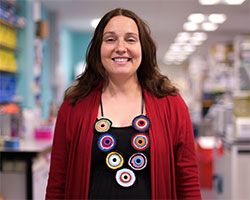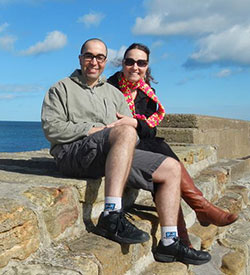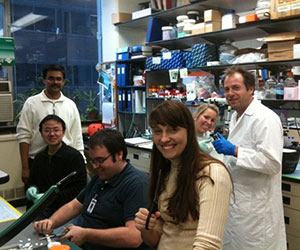

A Lab of Her Own
Dr. Czekster Gets Her Lab
Every Einstein grad aspires to go far, and Clarissa Melo Czekster, Ph.D. ’12, has done so in more ways than one: After six years as a postdoc, she’s inaugurating her own laboratory—in Scotland. She can make this move so early in her career thanks to a prestigious Sir Henry Dale Fellowship, a grant that supports postdoctoral researchers aiming to become independent scientists leading their own groups.

Clarissa Czekster, Ph.D., in her lab at University of St. Andrews, in Scotland (Photos in Czekster lab courtesy of University of St. Andrews)Receiving the fellowship is quite an honor; hundreds apply, but only the most promising are selected. The U.K. fellowship, which covers salary and research expenses, is the result of a partnership between the Wellcome Trust and the Royal Society. The funding lasts for five years, with the option to apply for three more. Clarissa was competing against other applicants who, according to the terms of the fellowship, are “already driving [their] research” and “ready to lead an independent research programme.”
Growing up in Porto Alegre, Brazil, Clarissa was always strong in math and chemistry. But when asked to declare her major at the Federal University of Rio Grande do Sul in Porto Alegre, she chose biology and biophysics—“on a whim,” she said, “with a little understanding and a lot of possibilities.” As it turns out, it’s not a bad thing to bring math and chemistry into a biology lab.
The Einstein Years

Clarissa with her husband and Einstein alumnus Dr. Rafael Guimaraes da Silva, on the beach near St. Andrews, where both work. Rafa was a postdoc in Vern Schramm’s lab“While doing undergraduate research in microbiology, I worked with someone who had been a postdoc at Einstein in Dr. John Blanchard’s lab and spoke highly of him,” she said. Clarissa joined Dr. Blanchard’s biochemistry lab in 2008 and felt welcome there as one of many international students. “Despite everyone’s language gaps, John was extremely patient and nice,” she said. “He runs a happy lab.”
Her husband, Rafael Guimaraes da Silva, who holds a Ph.D. in biochemistry, also came to Einstein to do postdoctoral work, for Dr. Vern Schramm, professor of biochemistry and the Ruth Merns Chair in Biochemistry. “We always planned our lives months in advance so we could be together,” she said of her and her husband’s placements in the same institution and department.
And Clarissa’s research? “I was working with Mycobacterium tuberculosis,” she explained. “We were trying to understand how it makes folate cofactor, which is required for bacterial survival. If we understood that, we could make molecules that would inhibit the process and then use them as therapeutic agents.”
Dr. Blanchard, a professor of biochemistry and the Dan Danciger Professor of Biochemistry, was pleased with her work. “Clarissa determined the kinetics and mechanisms of this protein and used a mathematical method that one reviewer of her paper in Biochemistry described as a ‘tour de force,’” he said. Based on her singular contributions, Dr. Blanchard made Clarissa the first and corresponding author. She later won Einstein’s Marmur Award for outstanding graduate student research.
Making Molecules
After graduating from Einstein in 2012, Dr. Czekster moved to the lab of Dr. Alanna Schepartz at Yale, where she worked with ribosomes that could make potentially therapeutic molecules that could not be coaxed out of bacteria naturally. Dr. da Silva got a job at nearby Pfizer.

At front, center: Clarissa, during her time as a Ph.D. student, with lab mates in the laboratory of John Blanchard, Ph.D.In 2015, Dr. Czekster became a research fellow in Dr. James Naismith’s laboratory at the University of St. Andrews in Scotland, where she researched proteins that make cyclic peptides—molecules with potential antimicrobial or anticancer activity. And the couple’s luck held; Dr. da Silva secured a biochemistry lectureship at the university.
When Dr. Czekster opens her own lab there this summer, her group will study small peptides that demonstrate anticancer, antimicrobial and antioxidant activity. “Every organism on the planet makes these peptides with interesting biological activity, but we don’t really understand how we can use that in our favor,” she explained. “My lab wants to characterize their biosynthetic pathways and then manipulate the enzymes involved to produce molecules of our choosing.” She also will oversee the work of a master’s degree student, a Ph.D. student and a postdoc.
The fellowship will allow Dr. Czekster to pursue new vistas in research, just as her new lab in Scotland offers her another kind of refreshing perspective. Through her windows there, Dr. Czekster can see the North Sea, and she and her small dog occasionally head to the beach.
Posted on: Friday, November 2, 2018

Tablet Blog